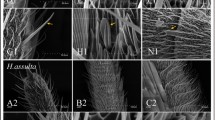Abstract
In insects, olfaction plays a major role in the regulation of behavior; accordingly, most insects discover the source of airborne cues with great sensitivity and accuracy. This is particularly true for the detection of sex-specific pheromones by male moths; they display an incredible odor perception and discrimination when flying long distances to “calling” females through turbulent air carrying the pheromone molecules. The pheromone plume originating from a single female moth shows a high degree of internal discontinuity due to turbulence (Murlis and Jones 1981). During the searching flight a male encounters and loses numerous pheromone packets en route to the female, leading to switches in flight behavior from an oriented zigzag flight to lateral casting which may occur as rapid as 0.5 sec after pheromone loss (Kennedy et al. 1980; Kramer 1975). The task of monitoring the temporal, spatial, and intensity parameters of pheromone plume and conveying the messages of this ever-changing environment to the animal’ s brain is accomplished by the extremely sensitive olfactory receptor neurons located in antennal sensilla. The sensillum is a bristle-like structure forming a hollow cuticular hairshaft housing the dendritic processes of the sensory cells; the inner cavity is filled with a fluid, the sensillum lymph, produced by auxiliary cells, which protect the delicate dendrites. The cuticular wall of the sensillum is perforated by tiny pores that permit access of volatile odor molecules but are small enough to retard loss of fluid. A common olfactory sensillum of moths, the sensillum trichodeum, consists of three non-neuronal auxiliary cells and at least two bipolar neurons which are specifically tuned to distinct components of a pheromone blend (Schneider 1969, 1992).
Access this chapter
Tax calculation will be finalised at checkout
Purchases are for personal use only
Preview
Unable to display preview. Download preview PDF.
Similar content being viewed by others
Editor information
Editors and Affiliations
Rights and permissions
Copyright information
© 1997 Springer Science+Business Media Dordrecht
About this chapter
Cite this chapter
Breer, H. (1997). Molecular Mechanisms of Pheromone Reception in Insect Antennae. In: Cardé, R.T., Minks, A.K. (eds) Insect Pheromone Research. Springer, Boston, MA. https://doi.org/10.1007/978-1-4615-6371-6_14
Download citation
DOI: https://doi.org/10.1007/978-1-4615-6371-6_14
Publisher Name: Springer, Boston, MA
Print ISBN: 978-1-4613-7926-3
Online ISBN: 978-1-4615-6371-6
eBook Packages: Springer Book Archive



